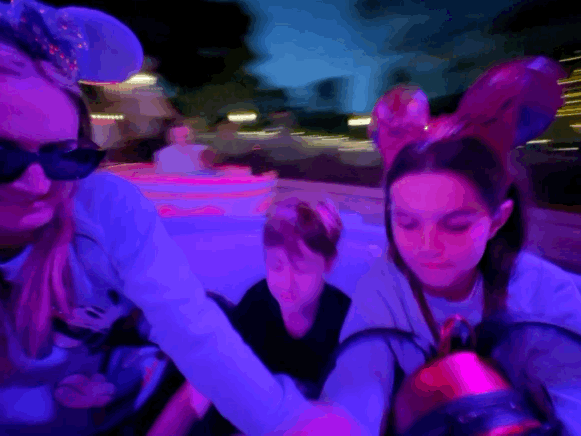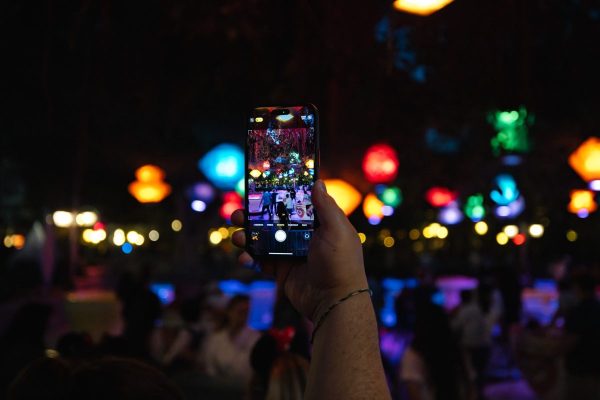Since 2014, I’ve been reviewing Apple’s latest iPhones at Disneyland. The rationale was, and is, simple: Instead of lab tests, do my best to get a feeling for what these devices will be like to use for people and families in a real-world scenario.
Disneyland offers the ability to test the capabilities of the battery, screen, radio and other features in a relatively high-stakes situation. If you’re spending a ton of hard-earned cash to squeeze the most amount of family joy out of a few days of vacation, you need your phone to work flawlessly, deliver high-quality images and video to preserve the memories, and last as long as possible on its battery charge.
After a hiatus last year, I was able to get back to my favorite testing ground with the iPhone 15 and iPhone 15 Pro Max. For the most part, I used the larger model, because it has the most clever camera and, I feel, the most obviously clear “this is the one to get” potential since the iPhone lineup expanded to multiple models.
I had two days and some change to drag the phones through the parks capturing video, making purchases, using them as virtual tickets and vacation planners for reservations, coordinating a friends and family group and more.
Each year’s review brings new surprises, even when you’ve got 15 years of hardware review experience. And this year’s iPhone cycle hit me with some of the biggest shocks I’ve ever had in this business. Which is nice, because this is probably my last year doing it.
I’ve had a hell of a fun time getting to test these things a bit early, and have always taken my responsibility as your avatar seriously. I want to get them out into real life and get a real handle on their perks and pitfalls and deliver you a review that gives you the specs in context, as well as a general vibe.
It’s been a privilege. I hope you get some value and enjoyment out of this review and the rad little short film we made for you.
Design
This year’s iPhones bring a lovely blend of the design languages Apple has employed since the first iPhone’s release in 2007. The flat edges are leavened in a really nice way by the large radius bullnose that transitions you from the titanium rim onto the ceramic glass front and back – a blend of the original iPhone’s pill shape and the drama of the iPhone 4’s flat-sided slab. They feel really, really good in the bare state, which makes it a shame that most people will obviously slap cases on them right away.

Image Credits: Will Proctor Productions
Though this review focuses on the iPhone 15 Pro models, I think it’s worth mentioning here that – even though the early reception is muted on the palette of colors – the iPhone 15’s frosted glass backs are really well done from an execution and color theory perspective. These do not play well in photographs – especially Apple’s high-contrast photography – but they look great in person. They’re subtle, sophisticated and well done. I know bolder colors would have played better from a distance, but up close I think a lot of folks are going to really love the mint and pink shades especially.

Image Credits: Will Proctor Productions
On the iPhone 15 Pro front, the PVD-coated titanium rims are also solidly executed. Yeah, some of the colors will pick up fingerprints quickly, but the finish is a really nicely restrained brushed execution across the lineup. The blue color that I tested is great, and throws off a bunch of different shades between the lens rims, the flat camera housing, the sides of the raised glass, the matte part of the back and the titanium rim. Really impressive execution that feels a lot deeper than the simple painted glass backs of a few years ago.

Image Credits: Will Proctor Productions
The ‘natural’ titanium color was my personal purchase (due some time in October, whew) and is really great as well. It’s less variegated than the blue, and reads very much as silver on gray, but I’m fine with that. The raw titanium sides are not actually raw at all, of course – they are PVD-coated with a specific gray that Apple designed to give people the most accurate read of “titanium.” Actual raw titanium is a bunch of different colors, but it plays just fine and since the coating is bonded, not painted, it has the feel of bare metal.
Blending glass into metal at the corners is probably only going to be a win on the board for those of us who go caseless, but my Disneyland trips almost always end up getting the case treatment just for that extra layer of protection.
The fine woven cases and wallet that Apple provided for this test are, well, fine? I found them to feel pretty nice to the touch, more like a microsuede than a canvas. Apple’s product photography didn’t do the texture any favors, making it look coarse where it is soft.
The cases I used didn’t pick up much dirt or scuffs during their time in the parks, nor did the wallet, which the phone rested on while on tables most of the time. I also got them quite wet on water rides and they held up fine with no buckling or wrinkling issues. They don’t feel as “premium” as a nice leather case does but I think they’ll hold up just fine for most people. I cannot, of course, vouch for how they’ll be in six months or a year – that’s a wait-and-see situation.
I should note, though, that I tested my iPhone 14 Pro alongside these new devices as my control, and it has a broken-in black leather case. That case is significantly more grippy and easy to hold onto because the surface has picked up skin oil and gotten weathered. The fine woven cases are significantly slicker, and if you’re fumble-fingered I think you should consider something third-party in leather or stick with Apple’s silicone offerings.

Image Credits: Will Proctor Productions
The USB-C port is mostly a non-event in terms of using them while mobile in the parks or in the hotels. Almost all hotel chargers are either still USB-A or they’ve got USB-C, as well as Lightning dongles built into them.
One factor that most early adopters will run into though is that if your other family members or kids have older phones, you’re constantly going to be trying to slip a Lightning cable into your USB-C slot, at least for a while as the older devices make their way through your family pipeline and into the used market or a recycling program. I carry a couple of portable batteries for the family in my pack and I had more than a handful of wrong-cord situations.

Image Credits: Will Proctor Productions
The addition of the Action Button is a really great quality of life improvement. I will personally likely be extremely basic about it and use the camera/shutter button option for the most part, but even that is super nice already. Pulling my phone out of my pocket with one hand while the other one is on a stroller or holding my kid’s hand and being able to activate the camera and shoot a picture without moving any fingers or adjusting my grip is a “sold” situation already.

Having the many other options, including Shortcuts connections and the other standard features, is just a great cream-on-top situation. Though I will never, ever discount the surfacing of accessibility features to a dedicated exterior physical button – that’s going to be workflow-changing for many who rely on those features and I’m excited to hear how people use it.
Performance and battery life
In my experience, the iPhone 15 Pro Max was able to leave the charging cable at around 7:30 a.m. and make it through to roughly 1% battery life by around 6:30 p.m. The things to know about that rough 11-hour runtime is that Disneyland is a particularly tough environment. Enormously radio rich, hot, demanding on mobile devices. That’s one of the reasons I like it so much as a testing ground.
A few years ago, one of Apple’s larger phones could get me through the whole day no problem. But in the modern Disneyland, your phone is everything. It’s your ticket, your day planner, your camera, your gateway to Genie+ (Disney’s fast track system), your primary wallet and coupon book, your map to wait times, your coordinating device for plans when you have kids and friends in different areas, your remote ordering and reservation system for dining – oh, and a phone.
It’s impossible to go to Disneyland and have anything like a pleasant experience without a smart device of some sort. On top of how an average person may use the phone, I was also testing the heck out of the camera and screen and any other new bit of hardware. Though I was able to make it just over 11 hours, I would say that the average new user of the iPhone 15 Pro Max will end up well north of that if they’re not going full tilt like me.
Of course, I’m never without a battery pack at Disneyland and suffered no downtime, but factors to consider!

Image Credits: Will Proctor Productions
Since I was shooting a lot of high definition video throughout the day, I did notice pretty significant heat coming from the back of the phone at certain points. The temperatures were far from the heights of summer, around 80 degrees or so. But I still found it really impressive that I did not get a single temperature-related shutdown or charging warning.
It’s impossible to tell whether Apple’s new molecularly bonded aluminum/titanium hybrid frame made a difference here, but it seems probable. The heatsink portions of the phone being aluminum enable it to wick heat quickly from the SoC, and having a bonded transition to the titanium means you don’t get transfer loss due to glue or other materials.

Image Credits: Will Proctor Productions
A lot of reviewers will be delivering specs-related benchmarks, and I’ll leave that to them. But in practical terms I can tell you that it feels really powerful. At one point I was recording 4K 60FPS video in ProRes log format to an external drive plugged in via USB-C while also screen recording that to local storage to illustrate for this review and there was nary a stutter.
Apple worked on the specs for USB-C, and it shares a lot of DNA with Lightning – reversible connector, varying grades of speed. But the overall convenience and the ability to do full external displays on iPhone as well as transfer the now-enormous 4K60 video files is welcome. Yeah, the EU may have pulled this particular port screaming into line, but it’s a line Apple had a big role in developing so it feels both momentous and pretty straightforward all at once.
The new screens are Super Retina XDR with ProMotion on both iPhone 15 Pro models. They’re still really solid. I had some initial issues with auto brightness really cranking low and then not registering brighter scenes, but it could have been an iOS 17 quirk and eventually evened out. The screens are fine! The iPhone 14 Pro’s screen was already killer and that hasn’t changed. You should see the same already great performance here.
Of note, if you’re using AirDrop in countries where peer-to-peer WiFi 6E has been approved, you’ll see faster transfer speeds. It has not been approved in the U.S. yet.

Image Credits: Will Proctor Productions
The iPhone 15 Pro and iPhone 15 Pro Max are both lighter than their previous iterations, thanks to the titanium bands. In practice, they instantly feel lighter when you pick them up and hold them – there are some interesting theories as to why. In my experience, it’s noticeable, especially when wrangling the larger phone with one hand outstretched for a photo. But it’s not earth-shattering.
Camera
Over the past decade, the vast majority of images I’ve captured at Disneyland have been from the iPhone. The course of the evolution of Apple’s camera packages is charitable in the various scenarios that play out during a typical trip. The selfies, the ride videos, the group shots, the dark rides, the parades. Each of them hit different elements – from low light capture to autofocus systems to lens quality.
The repeatability of these scripted scenarios has allowed me to create a barometer for performance that I can run each iPhone against.
The iPhone 15 Pro Max has absolutely blown the top off the mercury when it comes to photographic performance. This thing is a beast.
[gallery ids="2602151,2602153,2602154"]
The main sensor captures 24MP images that are a computational result of 48MP worth of information that is repeated and spliced together. The dynamic range and detail are noticeably better in every lighting condition. Especially, of course, when things get super contrasty. There is more shadow and highlight detail across the board. More texture in skin highlights, for example, and more color in specular areas.
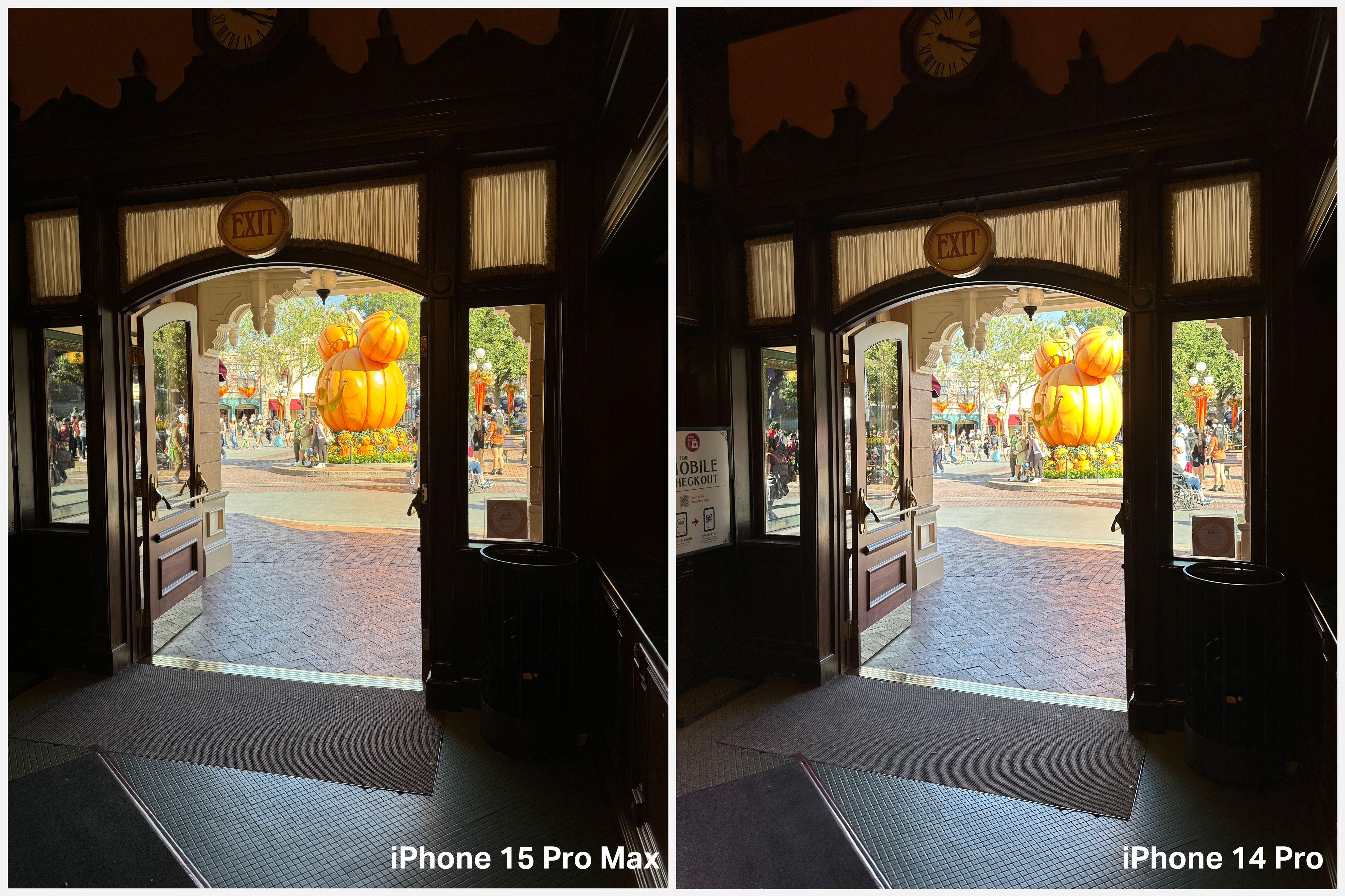
Image Credits: Matthew Panzarino
There is also noticeably better and more subtle color handling all around this year with Smart HDR 5. Open shade areas get warming to cut through the natural blueing that occurs, but they’re not cranked to the orange as can happen with auto correction schemes. Images shot in comparison with the iPhone 14 Pro show that they’re both very capable cameras – but the tuning on the iPhone 15 Pro trends toward restraint big time. Gone is even a hint of the hyper punchy brightness from HDR augmentation. Apple’s photo tuning was already a bit down on the hype scale from other brands like Google’s Pixel or many Samsung models – but now it seems like with all of this image data to work with and more range, Apple is more comfortable expanding the midrange and allowing the photos to “sit in the real” rather than to present an augmented representation.
[gallery ids="2602155,2602156,2602157"]
The result is that the warm afternoon light colors objects more realistically, while photos shot into the sun still have fleshed out shadow information and edge detailing. I cannot overstate how remarkable the results are across the spectrum, but especially in the main and telephoto cameras.
There is also a really nice concession to the photographically minded in that Apple has created realistic modeling and correction for 24mm, 28mm and 35mm “base lenses.” This isn’t digital cropping, by the way. The 24mm lens uses roughly 48MP to capture, the 28mm uses roughly 35MP to capture, and the 35MM uses exactly 24MP to capture; you’re getting all native quality with these lenses. This is similar to the way that the Leica Q handles it. In other words, feel free to choose your lens; your quality will be identical in HEIC or JPEG formats at 24MP. In RAW you’ll get the exact pixel counts.
[gallery ids="2602260,2602265,2602238,2602247,2602234,2602235"]
It’s a nice solve for those of us who felt that the 1x of the iPhone 14 Pro was just a little too wide. It’s not life changing but it’s super fun to have a default 35mm available to you if that’s your focal length. If you have no idea what I’m talking about then this isn’t for you, but if you’ve ever shot with these kinds of base primes and have a preference, then you know what I mean.
The new 2x is an un-interpolated 12MP image at 1.22 microns per pixel element also, giving you an “optically rendered” image at that resolution. It’s shot through the same element as the wide angle image that’s delivered at 24MP, but because the quad elements of the 48MP actual sensor are being used at a 1:1 level, Apple gets to claim optical quality here.
And we haven’t even started talking about the 120mm tetraprism-enabled 5x telephoto lens. This thing is an incredible achievement in every way. It doesn’t just work, it’s probably the best camera Apple has ever made.
In fact, if I were to sum up this entire review in just two photos, I’d submit these exhibits for you, shot through the ultra wide camera and the 5x camera in low light. Just look at them:
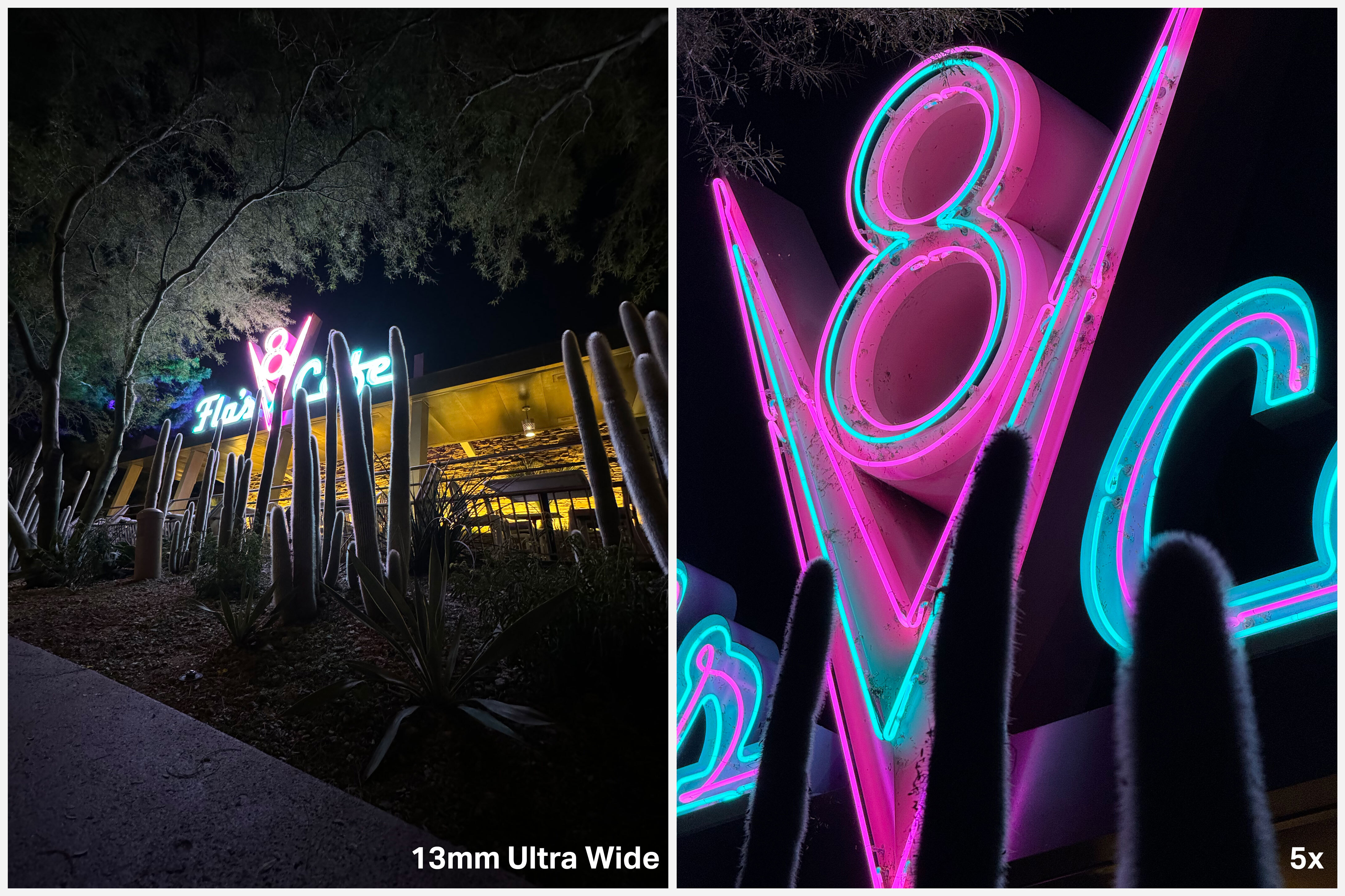
Image Credits: Matthew Panzarino
These are handheld shots in super low light from the same distance away. At the 5x, which still maintains an f2.8 aperture, you’re getting a ton of color tone, the foreground cactus gets a nicely smooth focus transition, the mid-ground cacti have clearly defined needles and the plant debris is visible in the grooves of the neon sign. It’s just a stellar capture and required no real setup or fiddling by me. I just shot it on the wing.
For your fiddling pleasure, here’s a high-res RAW file for you to download and play with. You’ll see what I see.
Though the camera shoots at 12MP, I’m still massively impressed by how the images hold together. The original 2x telephoto Apple shipped was nice to have, but only the iPhone 14 Pro’s recent 3x started becoming a real tool in the kit.
The 120MM lens is enabled by a tetraprism design that lengthens the lens flow by bouncing light inside of the lens chamber to emulate the magnification of a much larger chamber. This enables the lens to sit inside of the same size of chamber as the other two lenses. Pretty rad, to be honest, but also risky. In fact, I expected to see some issues here, either aberration or sharpness related, due to the prism elements. Instead, what we got was incredible excellence in camera engineering. Though there is more general grain present at 12MP than 24MP, the overall lens is crisp without being crunchy, still usable in low light and provides a hugely impactful sense of presence to portraits and mid-to-long-range zoom situations.
[gallery ids="2602166,2602167,2602168"]
This lens is also Apple’s first to get a 3D sensor-shift optical image stabilization system. It moves along all 3 axes to stabilize against hand movements or shake. It works great for stills but really blows the doors off when shooting video. Some of the handheld shots I took that we used in our film are so stable that they look like drone footage. It’s pretty wild.
The other lenses seem to be mildly improved stability-wise, too – Apple claims that they have upgraded those sensor shift systems, as well, though they are still 2D not 3D.
It’s a genuinely useful tool that will benefit everyone from the casual “I just wish I could get closer” photographer to the real portrait artist types. I even used it as a nice utility now and then, zooming over the heads of a crowd to grab a crisp image of a character string for an after-ride photo that I could then copy and paste into the Disneyland app to download our on-ride shots.
A little tidbit on the digital zoom above 5x: When you get way up there and it gets unwieldy, Apple projects a little map of where you are in the larger world with a box highlighting your current frame. It’s a little video game minimap to help you find your subject out at 25x. Pretty fun detail.
During the event I lamented that the iPhone 15 Pro Max was returning the lineup to having a fractured-choice scenario. If you wanted all of the new stuff, you had to buy the “big one.” In the end, though, with the slightly lighter chassis and the true brilliance of the 120mm lens, I have to say it’s a no brainer for me, and I ordered the Max with no regrets. This thing is a hit; people are going to love it.
Auto-portrait
I’m extremely happy to report that the auto portrait mode works fantastically. Shooting single portraits is a no brainer, of course, but even group shots in front of complex backgrounds or close ones like the wire mesh of a ferris wheel’s cage or the Millennium Falcon’s detailed panels couldn’t trip it up. Though Apple says it only works on humans, dogs and cats at the moment, I found that it also picked up cantankerous costumed adventurers and human sized dogs, as well.
[gallery ids="2602169,2602170,2602171"]
And having it auto-detect a portrait is such a great choice. Instantly capturing depth data to be used or not used later on by the photographer is a zero-cost affordance that is a long time coming. It was always just one of those ‘should I or shouldn’t I’ moments when you had to choose to switch over to portrait mode with its dedicated interface while snapping a shot.
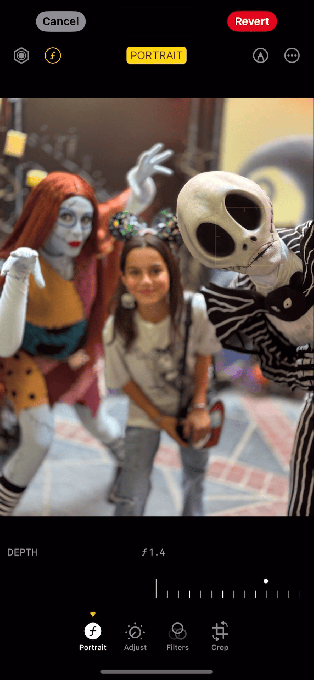
Extra cognitive load in the moment of snapping a shot is not what you want. You want as little as possible between snapping the picture and you. Especially in time-sensitive moments like a selfie on a ride or the few brief moments you have with a child’s beloved character in a meet and greet. And if you miss focus on one face or another, no problem, just pick the right one in post.
I would not be surprised to see the actual portrait mode deprecated down the line because this already works as a far better option.
Video
I’ll be honest, I was pretty skeptical about having 4K60 shooting available to me on device. I figured it would torpedo battery life, make the phone run hot and be lackluster in low light due to frame rate issues. None of that was true. In fact, as you can see in the footage we shot for our video review, the Max Pro didn’t just pull its own weight, matching a professional grade video camera, but it actually out-performed that camera in some low light and variable light situations.
I really enjoyed being able to rely on having a solid HD capture with great stabilization at a quality that I can count on being able to hold up for years right in my pocket. All of the exposure and sensor improvements here have been passed on to the video features.
And when you bring it around to shooting through the 5x lens with its brilliant 3D stabilizer – I can tell you it got some jaw-dropping shots. One segment in particular was a revelation. I shot some footage hand held from a moving Casey Jr. train car of a miniature Arendelle and it was so buttery smooth it looked like pro grade drone footage. Then, in the next moment, I whipped the camera around and shot the top of the Matterhorn with a plane flying by and the shot was so crisp it blended perfectly with a similar capture from the main Canon my video collaborator was using.
We also tested the new feature that lets you shoot ProRes 4K60 log straight to disk. It works great. We used a CFX reader and high-speed card attached with a Thunderbolt 4 cable. If you have a drive that has the proper power draw and write speed you can shoot solid 15 minute chunks to disk and it works great. To me it was a fun experiment to get some King Arthur’s Carousel footage – but shooting ungraded footage to drive is a huge boon to anyone who wants to use these as options in production environments.
I know Apple has managed to get iPhones to the level where they feel decent as a stunt or lightweight filmmaking option. But I think that with the new lenses and the ability to shoot straight to drive with log and ACES, it’s earned an instant-add slot to anyone’s shooting kit. Including pros.
Conclusion
It was interesting watching the public consensus roll out after Apple’s recent iPhone event that it was “boring” and didn’t deliver anything truly exciting. I think that in many ways this result is unsurprising and sort of a byproduct of the Apple engine being geared in a certain way for so long. They have this huge product at the center of their ecosystem and it demands this kind of launch no matter what.
At the same time, the outer bounds of the product are relatively established. Without an extra widget to strap to the outside, it becomes a game of how clearly Apple can communicate with its audience just how much work was being done inside those bounds to make the thing they use every day that much better.
[gallery ids="2602173,2602174,2602175"]
Regardless of the mis-match of current communications style and the truly high level of engineering execution, I think that the one message Apple needs to make clearer is one that they did spend a bit of time on in the keynote: We are going to insane extremes on an engineering level to deliver marvels of execution to you in ways that you don’t have to change any of your behaviors to reap the benefits of.
That’s enormously critical in a mature technology product. Being able to deliver big improvements in a camera is great, but being able to do it without incurring any additional usage or operational debt on the part of the user is actually huge. Automatic portrait mode allows Apple to offer the radically user-centric option of ‘just shooting a picture’ with an engine that allows people to do whatever they want after the fact.
This kind of zero-cost optionality is what computational photography does at the best of times. It takes the load off of the user but enables more choice and more flexibility.
I’m reminded of one of the year’s other big technology hits: Baldur’s Gate 3. If there was anything that really punched through the haze for BG3 players it was the fact that Larian Studios seemed to have hung the entire enterprise on near-prescient anticipation of user intent. Want to defeat an enemy by dropping a larger enemy on top of them? No problem. Killing spiders with boxes? Sure. Solving a puzzle by having one character throw another one? Why not?
That kind of invitation to experiment made the somewhat smallish game feel exponentially larger and more detailed than it ever was. And they accomplished it without creating all kinds of weirdly explicit user interface options. It just felt intuitive.
Apple in many ways is working inside the iPhone box to enable more user choice and flexibility without users having to learn anything new. So many bits of the iPhone 15 Pro Max are about choice. The Action Button lets you define what behaviors are most important to you, the wide range of lenses available give you better framing and utility options, hell even the legally mandated USB-C gives you professional grade video shooting and external monitor support.
Yes, the iPhone as a class of device is a mature instrument. But the iPhone 15 Pro and iPhone 15 Pro Max prove that there is so much more room for Apple to grow the archetype. It will just be growing inwards vs. outwards.
Thanks to Henry Pickavet, Yashad Kulkarni, Will Proctor Productions and all of you, dear readers!
